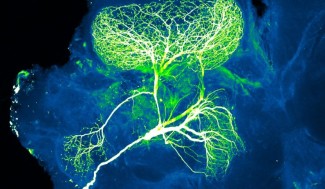To adapt to the small and large events that give the world its ever-changing character, we use an essential ability: cognitive flexibility. It enables us to improvise in the event of disruptions on our morning commute, to cope with the unexpected behavior of a loved one, or to get used to living in a new country. Kathleen Cho (Inserm) at Paris Brain Institute, and her colleagues from Vikaas Sohal's laboratory in the Department of Psychiatry and Behavioral Sciences at the University of California, have described, in mice, a class of neurons specialized in this ability to adapt. The researchers show that disturbances in their functioning could play a role in the onset of psychiatric illnesses characterized by a certain cognitive rigidity, such as schizophrenia. These results are published in Nature.
To adapt to perceived changes in our environment, the brain constantly updates the activity of neural circuits in the prefrontal cortex, a region involved in attention, anticipation, and decision-making. But until now, researchers did not know what mechanisms were responsible for these modifications – which are essential to rodents, primates, and humans if they are to survive.
By studying this fascinating ability, we have found a specific type of neuronal connection in the prefrontal cortex, which helps to update our representation of the world – and more importantly, its rules. Thanks to it, we don't persist in using an inappropriate strategy to achieve a goal. Such as typing in an out-of-date code, again and again, to unlock a door.
This newly discovered connection is formed by inhibitory neurons, a class of nerve cells capable of dampening the activity of other neurons. Researchers thought these inhibitory neurons transmitted electrical and chemical information to areas situated in their immediate vicinity. But while exploring how they work in mice, Kathleen Cho and her colleagues at the University of California have made an important discovery. “We observed that a subclass of inhibitory neurons, parvalbumin-expressing interneurons, could communicate with neurons situated very far from them, in the opposite hemisphere of the prefrontal cortex,” says the researcher.
The Secrets of a long-distance relationship
To better understand the exact function of these interneurons, the team observed their activity in mice during an ingenious test. The researchers presented the animals with bowls in which food was hidden. At first, the presence of garlic or sand in the container indicated the precise location of the reward. Then, this clue was replaced by another, forcing the mice to identify and exploit the new rule to unearth the food.
However, when the famous long-distance inhibitory neuronal connections were deactivated in a group of rodents via an optogenetic technique, they proved incapable of adapting to change. They continued to search for food wherever they detected sand or the smell of garlic. In a way, the mice were stuck in their old habits...
The researchers also showed that the long-distance inhibitory connections synchronized variations in high-frequency neuronal electrical activity – gamma oscillations – between the two hemispheres of the prefrontal cortex. “This synchronization was associated with a particular event: the moment when the mice realized that the rule was no longer valid,” Cho says.
The effects of this synchronization, surprisingly, persist over time. Mice in which parvalbumin-expressing interneurons had been deactivated remained unable to integrate new rules for several days. Subsequently, the artificial stimulation of gamma synchronization compensated for this deficit and fully restored their adaptive capacities.
A slight lack of flexibility
Previous research has shown poor synchronization of gamma waves in the prefrontal cortex, and abnormalities in inhibitory neurons exist in many schizophrenic patients. This psychiatric illness results in great difficulty in adapting to change – a symptom also observed in bipolar disorder or autism spectrum disorder.
Further studies will be needed to determine what role dysfunctional inhibitory neuronal connections might play in these diseases. “We don't know precisely which cells in the prefrontal cortex receive information via these long-distance connections, adds the researcher. We also don't know what molecular mechanisms are involved in long-term changes in neuronal activity”. Answering these questions could help us understand under what conditions the brain gives up retaining certain information... and opens to novelty.
Reference
Cho, K.K.A. et al., Long-range inhibition synchronizes and updates prefrontal task activity, Nature, 2023. DOI: 10.1038/s41586-023-06012-9.
Sources
This study was carried out thanks to Inserm, the Marie Skłodowska-Curie Horizon 2020 program, the University of San Francisco, the NIH, the McKnight Endowment Fund for Neuroscience, and the Brain Research Foundation.







